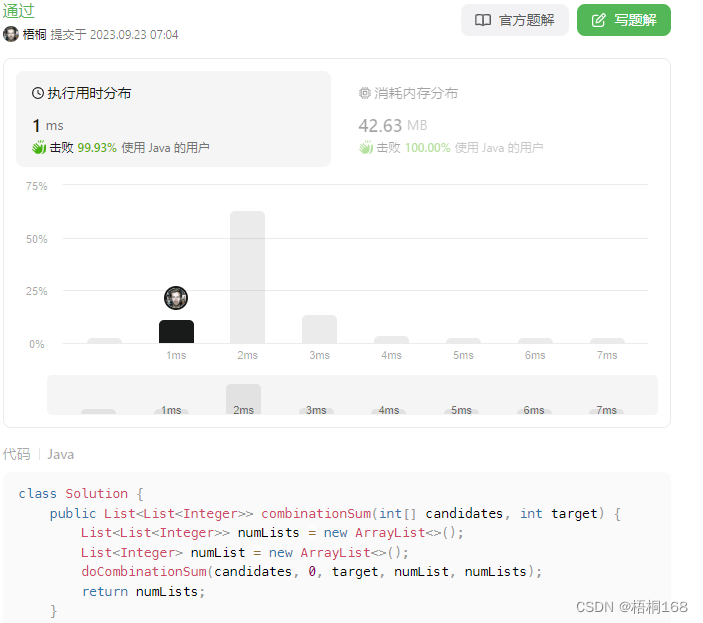【题目描述】
给你一个 无重复元素 的整数数组 candidates 和一个目标整数 target ,找出 candidates 中可以使数字和为目标数 target 的 所有 不同组合 ,并以列表形式返回。你可以按 任意顺序 返回这些组合。candidates 中的 同一个 数字可以 无限制重复被选取 。如果至少一个数字的被选数量不同,则两种组合是不同的。 对于给定的输入,保证和为 target 的不同组合数少于 150 个。
示例 :
输入:candidates = [2,3,6,7], target = 7
输出:[[2,2,3],[7]]
解释:
2 和 3 可以形成一组候选,2 + 2 + 3 = 7 。注意 2 可以使用多次。
7 也是一个候选, 7 = 7 。
仅有这两种组合。
示例 2:
输入: candidates = [2,3,5], target = 8
输出: [[2,2,2,2],[2,3,3],[3,5]]
示例 3:
输入: candidates = [2], target = 1
输出: []
提示:
- 1 <= candidates.length <= 30
- 2 <= candidates[i] <= 40
- candidates 的所有元素 互不相同
- 1 <= target <= 40
【题目链接】. - 力扣(LeetCode)
【解题代码】
package dp;import java.util.*;public class CombinationSum {public static void main(String[] args) {//int[] candidates = {2, 3, 6, 7};int[] candidates = {1, 2, 3};System.out.println("开始计算。。。");long start = System.currentTimeMillis();List<List<Integer>> numLists = new CombinationSum().combinationSum(candidates, 4);System.out.println("运行时长:" + (System.currentTimeMillis() - start) + "ms");for (List<Integer> numList : numLists) {System.out.println(Arrays.toString(numList.toArray()));}}private List<List<Integer>> combinationSum(int[] candidates, int target) {List<List<Integer>> numLists = new ArrayList<>();List<Integer> numList = new ArrayList<>();doCombinationSum(candidates, 0, target, numList, numLists);return numLists;}private void doCombinationSum(int[] candidates, int n, int target, List<Integer> numList, List<List<Integer>> numLists) {if (target == 0) {numLists.add(new ArrayList<>(numList));} else if (n < candidates.length) {doCombinationSum(candidates, n + 1, target, numList, numLists);if (target >= candidates[n]) {numList.add(candidates[n]);doCombinationSum(candidates, n, target - candidates[n], numList, numLists);numList.remove(numList.size() - 1);}}}}
【解题思路】
看到此题描述,第一反应就是应该采用“回溯算法”:依次遍历数组candidates 里面数字,根据题意对当前索引i的数字做两种选择:
- 当前数字candidates[i]不加入候选队列:直接递归处理下一个索引数字i+1;
- 当前数字candidates[i]如果小于target,选择将其加入候选队列:将目标整数 target减去当前candidates[i],因为数字可以重复选择,再次递归处理索引数字i;
- 目标整数 target为0,说明当前候选数字序列满足要求,添加到结果集,此趟递归结束
- 按照上述思路完成代码编写,提交LeetCode成功

【解题步骤】
- 定义一个回溯递归函数doCombinationSum,参数包括整数数组 candidates,当前索引值n,目标值target,当前候选数列numList,结果数列numLists:
private void doCombinationSum(int[] candidates, int n, int target, List<Integer> numList, List<List<Integer>> numLists) - 如果目标值target为0,说明当前候选数字序列numList满足要求,添加到结果集numLists
if (target == 0) {numLists.add(new ArrayList<>(numList)); } - 如果数组遍历还没遍历完,首先选择不选择当前数字,直接递归处理下一个索引数字即可
} else if (n < candidates.length) {doCombinationSum(candidates, n + 1, target, numList, numLists); - 接下来,如果当前数字小于等于目标值target,那么选择此数字,将此数字添加到候选数字序列,将目标值target去当前candidates[i],并从当前索引重复递归,递归完毕,回溯将次数字从候选数字序列中删除
if (target >= candidates[n]) {numList.add(candidates[n]);doCombinationSum(candidates, n, target - candidates[n], numList, numLists); numList.remove(numList.size() - 1); }
【思考总结】
- 了解掌握回溯算法定义:回溯算法定义 回溯算法,是一种选优搜索法,又称为试探法,按选优条件向前搜索以达到目标。 回溯算法简要说:但当探索到某一步时,发现原先选择并不优或达不到目标,就退回一步重新选择,这种走不通就退回再走的技术为回溯法。 而满足回溯条件的某个状态的点称为“回溯点”。
- 回溯与递归的区别:递归的基本性质就是函数调用,在处理问题的时候,递归往往是把一个大规模的问题不断地变小然后进行推导的过程。 回溯则是利用递归的性质,从问题的起始点出发,不断地进行尝试,回头一步甚至多步再做选择,直到最终抵达终点的过程;
- LeetCode解题之前,一定不要看题解,看了就“破功”了!
![[NISACTF 2022]bilala的二维码](http://pic.xiahunao.cn/[NISACTF 2022]bilala的二维码)
)


的实现(java版))














